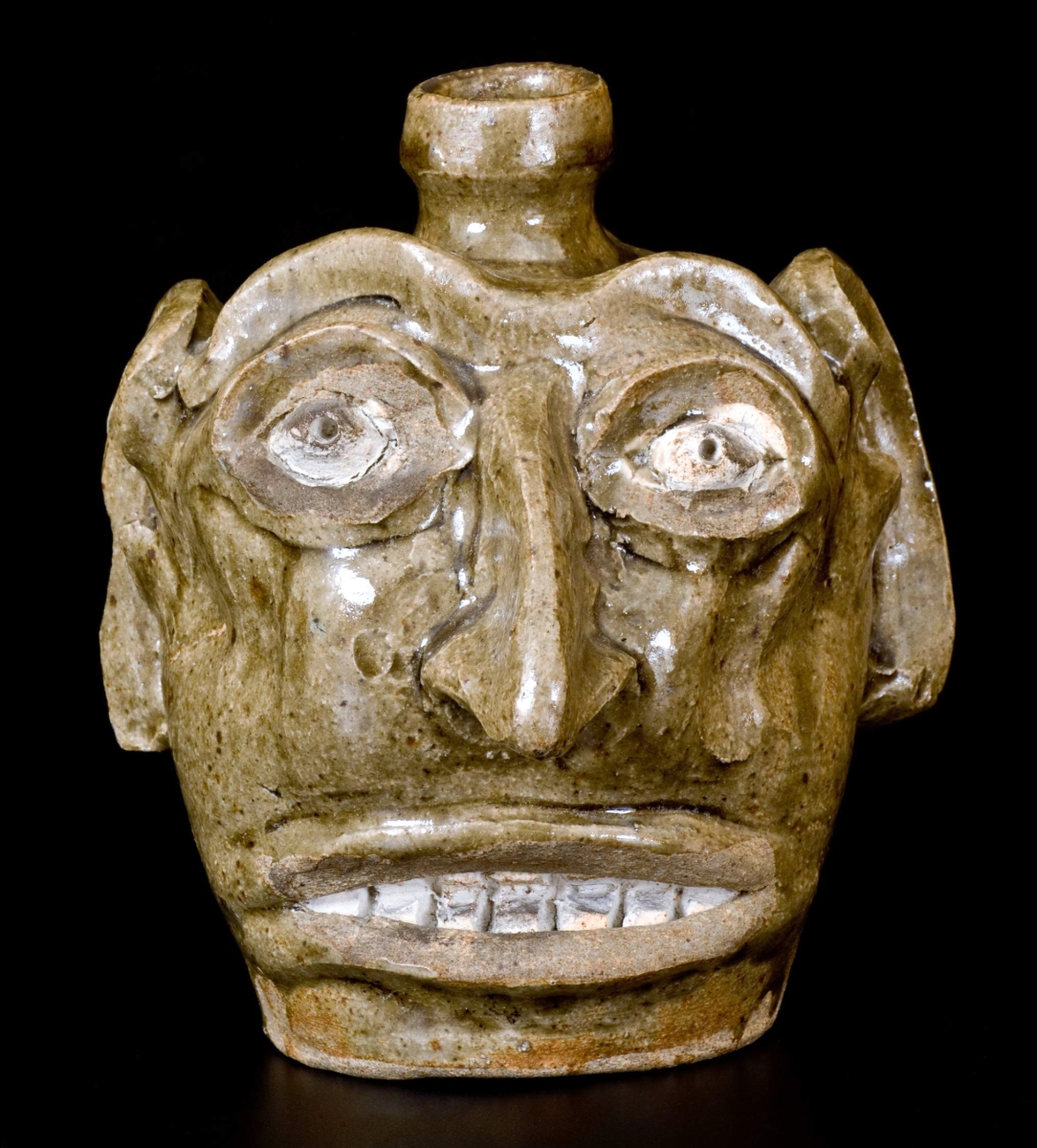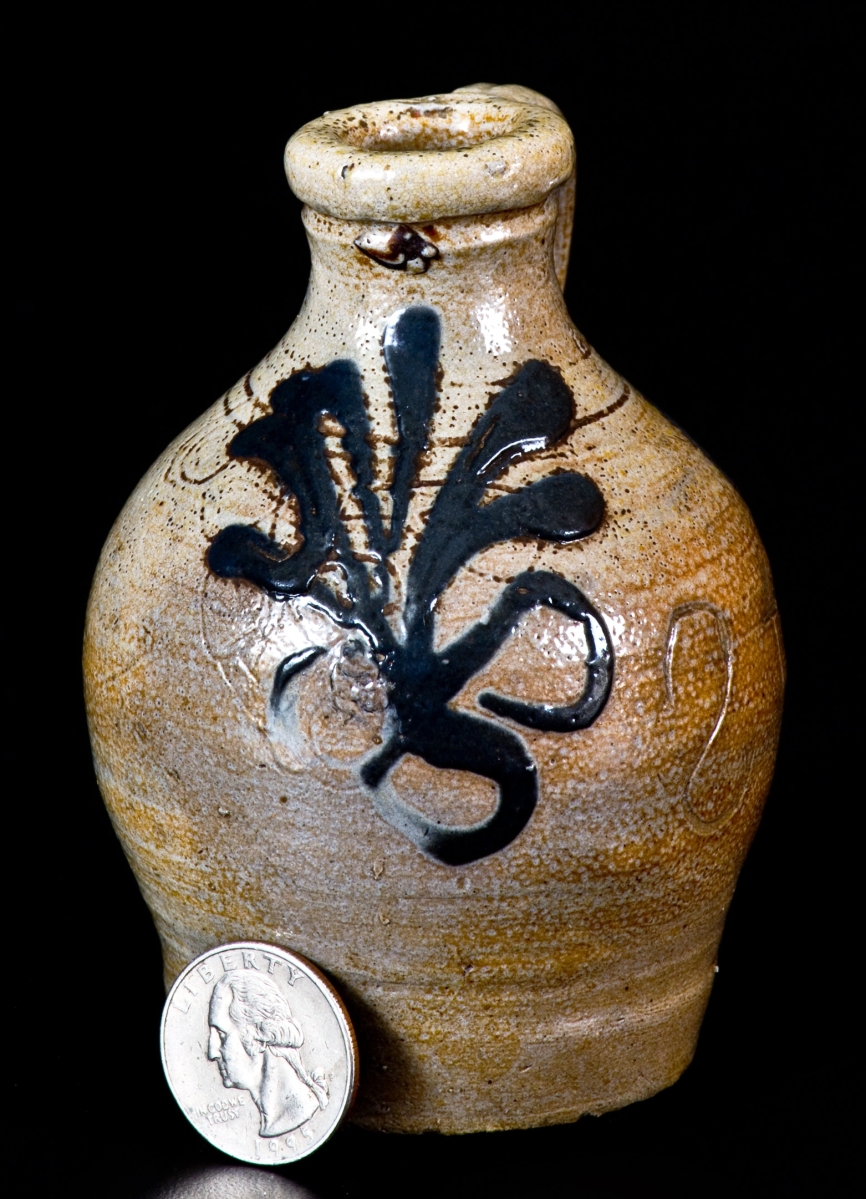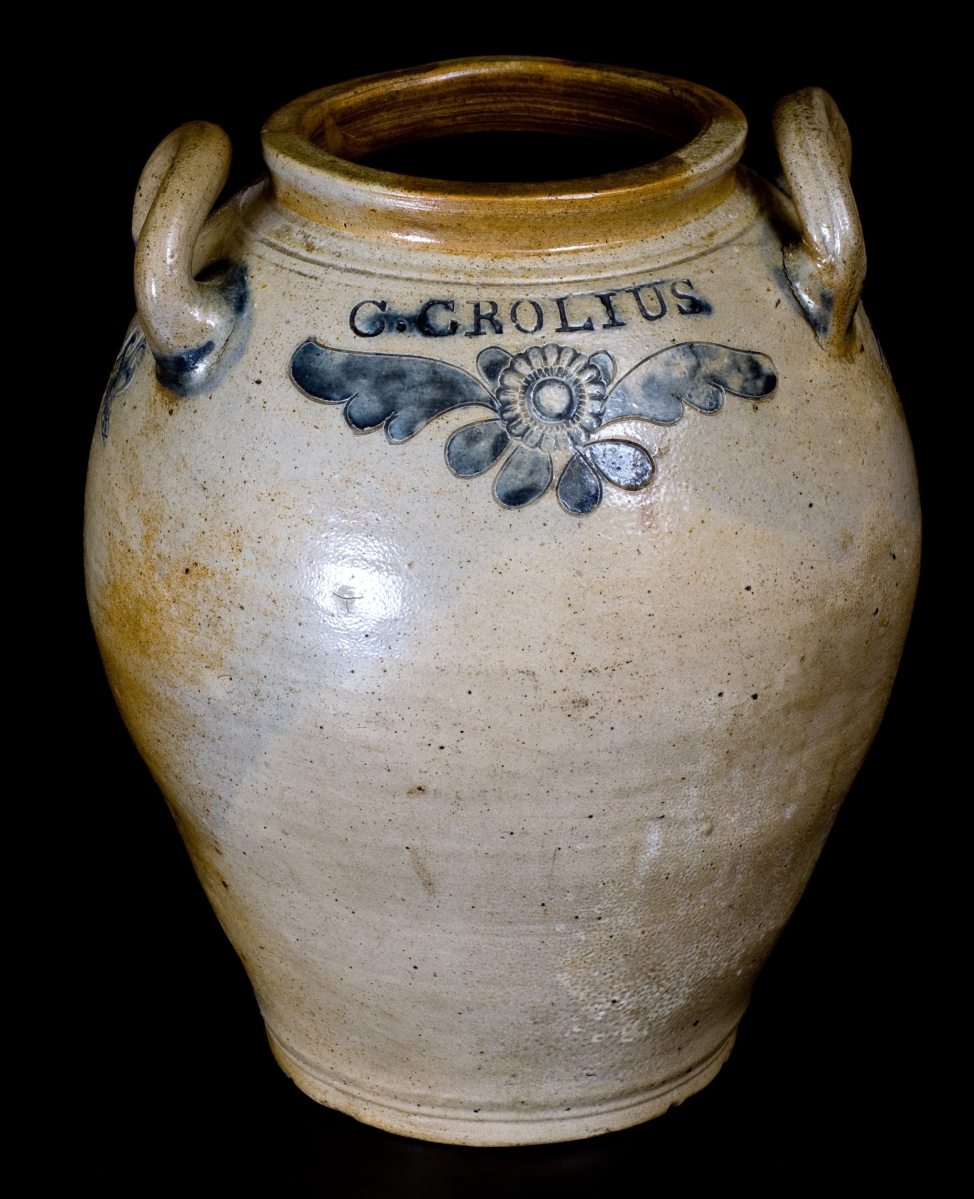
The sale’s top lot was this folk art face jug, Edgefield, S.C., circa 1845–60, which sold for $47,200.
Review by W.A. Demers, Photos Courtesy of Crocker Farm, Inc.
SPARKS, MD. – Crocker Farm’s early spring, midsummer and fall auctions of American stoneware and redware have been growing in size as enthusiastic new sellers and buyers discover rarities in attics, basements and barns. “It’s remarkable,” observed Tony Zipp, patriarch of the family business. “We had something like 1,500 left bids on 541 lots in this last sale – almost every lot had a bid on it – and 240 different high bidders, a lot of them new customers. There is an enthusiasm for good-quality stoneware that we haven’t seen before.”
That enthusiasm was on full display at the firm’s March 25 sale where a rare alkaline-glazed stoneware face jug with kaolin eyes and teeth, Edgefield, S.C., origin, circa 1845-60, took top dollar. Estimated $20/30,000, the ovoid jug with semisquared spout and hand-modeled and applied clay face brought $47,200.

This rare miniature stoneware jug attributed to Adam States (Manhattan), circa 1745, realized $36,580.
With a large mouth with kaolin teeth, pronounced nose with depressed nostrils, single curving eyebrow, large ears and pierced eyes set into wide lids, brushed with kaolin slip, its surface was covered in an a light-green alkaline glaze over a light, buff-colored clay ground.
The jug, which recently surfaced, is regarded by Crocker Farm as the finest among a group of four Edgefield examples collected in New York State during the 1970s. The first three were sold through Crocker Farm in 2015 and 2016.
Catalog notes indicate that the jug’s form, glaze and quality of workmanship suggest that it may have been made early in the Edgefield District’s foray into face jug production, possibly predating the arrival of the Wanderer slaves. While many Edgefield face vessels exhibit a naive quality, the superior craftsmanship of this example indicates a true artist familiar with hand modeling, sculpting and the techniques involved in creating this coveted Southern folk art form.
“Good Southern stoneware is in demand,” said Zipp of Crocker Farm. “We had ten phone lines active on this piece,” adding that it went to a Virginia dealer on the phone.
An auction surprise was a rare miniature stoneware jug with scrolled handle and slip-trailed cobalt foliate and watchspring decoration attributed to Adam States Sr of New York City, circa 1745. It leaped beyond its $5/8,000 estimate to finish at $36,580, going to a Virginia dealer. “We sold a similar piece in the past for about $10,000, and we thought maybe it might even bring $15,000,” said Zipp. “So many people looked at this piece. The condition was pristine, it was early, mid-1745, and it had the ‘S+’ initials.”
It is Crocker Farm’s usual practice to start each sale off with a bang, presenting what it believes will be the marquee item as the first lot. For this sale, the expected star was a two-sided stoneware pitcher of monumental size attributed to the Cassville, Penn., pottery of Elisha B. Hysong, circa 1850. It was both extremely rare and possessed over-the-top decorative appeal, according to Zipp. The two-faced pitcher, however, estimated $50/70,000, was passed. Zipp said two contributing factors were the fact that its handles had been restored and its estimate may have intimidated some potential buyers. Ironically, after the sale, an attendee approached Zipp and offered to purchase the piece for the $50,000 reserve plus premium, “but the consignor said ‘no,'” said the auctioneer, and it was returned to him.
Meanwhile, face jugs performed fiercely. Another stoneware face jug soared from its presale expectations. Estimated $10/20,000, a rare Miles Mill, Edgefield, S.C., example surged to a final price of $33,040. Made circa 1875, the tapered jug with sloped shoulder was decorated with a hand modeled and applied clay face. Its eyes and lips and teeth were buff colored and thus stood out from the dark olive-brown alkaline glaze. Catalog notes point out that, unlike most surviving Edgefield face jugs that exhibit two rows of gritted teeth, the artist here has created only one row, resulting in a less fearsome expression.
That may have been reserved for the very next lot, also a Miles Mill face jug, circa 1875, a cylindrical jug, wide and squat, whose open mouth bristled with applied teeth formed with a pointed stylus. With pinched nose and asymmetrical face and fetching an above-high-estimate $18,880, the jug was considered important because of this asymmetry, one eye placed below the other. Crocker Farm stated that while this treatment can be found among the work of Twentieth Century face jug masters like Lanier Meaders and Burlon Craig, it is rare to see it applied in the Nineteenth Century Edgefield tradition. The catalog notes that a related example with typical eyes resides in the collection of the New-York Historical Society, acquired in 1937 from the noted folk art collector and avant-garde sculptor Elie Nadelman (1882-1946).
The remainder of the auction’s top highlights fell into the traditional zone of New York state, Pennsylvania and Maryland pieces that are hallmarks of the firm. Fetching $31,860 from a Virginia collector – way above its $5/7,000 estimate – was an extremely rare C. Crolius / Manhattan, Wells / New-York jar with impressed eagle and floral motifs. Clarkson Crolius Sr produced this early Nineteenth Century 2-gallon ovoid stoneware jar with footed base and open loop handles. Under each handle of the 12-inch-high jar was an impressed and cobalt-highlighted design of a spread-winged eagle standing on a mound. Impressed on the front with the cobalt-highlighted maker’s mark was “C. Crolius,” and on the reverse with the remainder of the mark, “Manhattan-Wells / New-York.” Decorated below these stamps on the front and reverse was an impressed design of a flower blossom surrounded by incised leaves, all highlighted in cobalt slip. Crocker Farm said it has only seen two other Crolius examples with this eagle motif. Thematically, the eagle designs reveal a growing sense of nationalism for the young American nation and boldly profess America’s independence as a stoneware producer.
Early in the sale, a possibly unique 5-gallon stoneware pitcher of Baltimore, Md., origin also brought $31,860. Lavishly slip-trailed with cobalt decoration and possibly by Henry Remmey Sr, circa 1820, the monumental, ovoid-bodied pitcher with footed base featured a narrow collar accented with tooled lines and a heavily ribbed handle. The vine design decoration was punctuated with graduated leaves and clusters of grapes or berries, meeting at the lower handle terminal on the reverse. Stately at 18 inches high, it is one of the largest American stoneware pitchers known, only outsized by a few iconic works, such as the Harrington & Burger hound-handled eagle pitcher in the Adam Weitsman collection at the New York State Museum in Albany, N.Y. It is surmised that the 5-gallon example may have served as a display piece in a shop window.
Also profusely decorated was a Remmey, Philadelphia 1874 presentation pitcher with incised birds that took an above-high-estimate $23,600. Inscribed “Jonah Knight / Novbr 18th 1874,” it was attributed to Henry Harrison Remmey or Richard Clinton Remmey, Philadelphia. Small in size at 8 inches high with a vase-like form, footed base and swelling midsection, the pitcher’s front and side featured an incised and cobalt-highlighted design of a bird on a flowering branch. “The finest Philadelphia stoneware pitcher we have ever offered,” said Crocker Farm in its catalog entry for the lot.
A 5-gallon stoneware water cooler also outperformed, bringing $22,420 against a $10/20,000 estimate. By John Burger of Rochester, N.Y., the 15-inch-high piece, circa 1860, had profuse cobalt floral decoration and was stamped “John Burger / Rochester.” With flared rim, applied lug handles and applied circular bunghole at base, the cooler’s front was decorated with an artistically applied slip-trailed design of two daisies extending from large leaves at the base. Around the bunghole were a series of slip-trailed ovals. Few water coolers by John Burger are known, according to the auction house.
Serving as a kind of Rosetta stone for attributing unsigned pieces incorporating incised fish decoration, a C. Crolius / Manufacturer / New-York 1-gallon stoneware syrup jug more than doubled its high estimate, realizing $18,880. The early Nineteenth Century, squat-shaped jug with tooled shoulder and spout featured an incised and cobalt-highlighted design of a fish with large eye, fin details and a scallop-edged tail on its front aspect. The firm remarked that while a small number of unsigned Manhattan stoneware products have survived with incised fish designs, this 10-inch-high jug is the first signed example from the city it has seen.
No Crocker Farm auction is complete without an offering of choice redware, and a notable piece in this auction was a ring bottle attributed to Moravian potter Rudolph Christ, Salem, N.C., circa 1800, which was bid to $18,880, more than three times its high estimate. The rare multiglazed late Eighteenth or early Nineteenth Century, ring-shaped bottle with attached footed base and pouring spout with semirounded mouth featured an open midsection surrounded by two incised lines. Its surface was covered in a heavy, cream-colored slip, decorated with sponged copper and manganese and covered in a clear lead glaze. It was accompanied by family history indicating that it had been used during the Civil War by a soldier from Illinois.
All told, Zipp said that he was very pleased with the sale, both in terms of the amounts realized and the turnout. “We had people in their 30s, 40s and 50s in the gallery. It’s getting to be incredible,” he said.
Prices reported include the buyer’s premium. Crocker Farm is currently preparing its July 22 stoneware and redware auction. For more information, 410-472-2016 or www.crockerfarm.com.
















